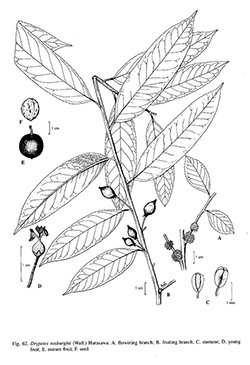e-Flora of Thailand
Volume 8 > Part 1 > Year 2005 > Page 249 > Euphorbiaceae > Drypetes
14. Drypetes roxburghii (Wall.) Hurusawawfo-0000946649
J. Fac. Sci. Univ. Tokyo, Sect. 3, Bot. 6: 335. 1954. Fig. 62.
Accepted Name : Putranjiva roxburghii Wall.
Tent. Fl. Nepal.: 61. 1826; Müll.Arg. in DC., Prodr. 15(2): 443. 1866; Kurz, Forest FI. Burma 2: 366. 1877; Hook.f., Fl. Brit. Ind. 5: 336. 1887; Craib, Bull. Misc. Inf. Kew: 461. 1911, Steenis, Blumea 8: 515. 1957: Backer & Bakh.f., Fl. Java 3: 465. 1963; Airy Shaw, Kew Bull. 26: 257. 1972.
Description : Tree, up to 15 m high, with drooping leaves, dioecious; bark thin, grey; young shoots pubescent, branches glabrescent. Leaves distichous; petiole 0.5–1 cm long, pubescent; blade oblong, oblong-elliptic or elliptic, 4–14 by 2–5 cm, subcoriaceous, glabrous, base obliquely cuneate, margin crenate or serrate, slightly undulate, apex acuminate, acute or obtuse, dark green above, light green beneath; nerves very thin, irregularly arranged, veins and veinlets reticulate. Flowers yellowish green. Staminate flowers axillary in dense clusters or clustered on a 1–3 cm long peduncle, 1–2 mm in diam.; pedicel short; sepals 4 or 5, unequal, margin ciliate; stamens 3 or 4, filaments 0–2 mm long; anther semiglobose, sparsely hairy or glabrous; disc absent. Pistillate flowers 1–4 together; pedicel short; sepals 5, lobes erect, very unequal; ovary densely hairy, contracted into the style, 2- or 3-locular; stigmas 2 or 3, recurved, subsagittate, caducous. Fruits on a 4–16 mm long pedicel, ovoid to globose, 1.5–2.7 by 0.6–2 cm, white tomentose. Seed 1.
Thailand : NORTHERN: Chiang Mai (Doi Chiang Dao, Fang, Hot, Mae Tuen), Tak (Phumiphon Dam), Kamphaeng Phet, Nakhon Sawan; NORTH-EASTERN: Phetchabun; EASTERN: Khon Kaen, Nakhon Ratchasima (King Ban Yang, Muak Lek); SOUTH-WESTERN: Uthai Thani (Huai Kha Khaeng), Prachuap Khiri Khan (Kui Buri, Sam Roi Yot); CENTRAL: Ang Thong, Saraburi (Phu Khae); SOUTH-EASTERN: Chon Buri (Ko Khram).
Distribution : W Himalaya to Ceylon and Burma, Indochina (Laos, Cambodia), Java, Maluku, Lesser Sunda Islands, Papua New Guinea.
Ecology : In evergreen forests, deciduous forests with bamboo, scrub jungle, on granite bedrock or on limestone mountains, along streams, up to 550 m alt.
Vernacular : Ma ong nok (มะองนก)(Northern); mak kho (มักค้อ)(Khon Kaen); ma kham kai (มะคําไก่), ma khain di kai (มะคําดีไก่), prakham kai (ประคําไก่)(Central).
Uses: Bark and leaves used as medicine; leaves used as tea by Karens.

